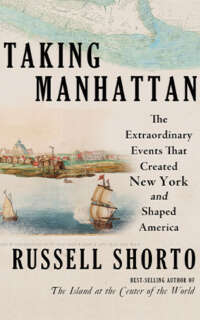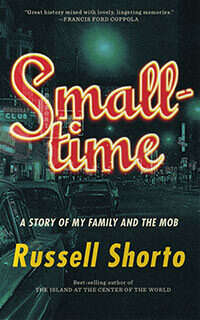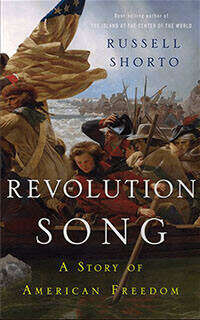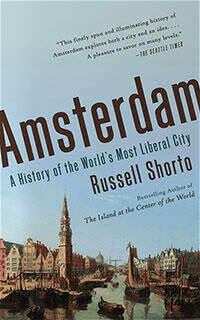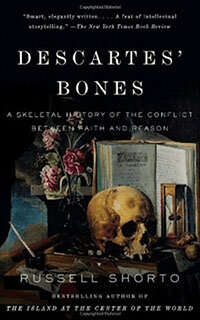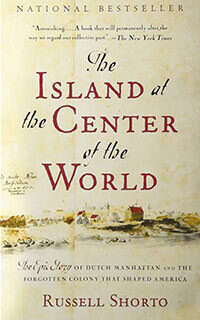This Very, Very Old House
The New York Times Magazine
by Russell Shorto
March 05, 2006
In 1625, a carpenter named Pieter Fransz built a house on the outskirts of Amsterdam. He was young, ambitious and lucky enough to belong to one of history’s greatest generations: his life spanned the course of his country’s golden age, when tiny Holland became an empire and Amsterdam grew into Europe’s wealthiest city. Fransz walked the streets with Rembrandt; he saw a forest of masts grow in the harbor, as ships returned from the East Indies laden with pepper and nutmeg, a sack of which could make a man wealthy for life. He and his family prospered along with the city; 17 years after building his house, he was rich enough to buy the one next door, into which his daughter and her husband moved. In 1683 he was still listed as the owner of both properties. Happiness isn’t registered in municipal archives, but the image of this one not terribly consequential human life that remains on the palimpsest of time speaks of contentment: a man who has lived beyond the normal life span of his era, surrounded by family, financially successful.
Most of us leave no lasting traces that recall our stay on the planet, but through accident and fate, Fransz left something that has endured the centuries. His house — an elegant redbrick step-gable, its façade ornamented with sandstone bands and wooden cross-framed windows, a building that has more of the Renaissance than the Baroque about it — still stands. Napoleon and Hitler conquered Amsterdam in their separate centuries; later, postmodern architects and the sex and soft-drug industries made their marks. Pieter Fransz’s house withstood all.
The Dutch have always been meticulous recordkeepers, so it is possible to follow this house, and others nearby it on Amsterdam’s famous Herengracht, or Gentlemen’s Canal, as they make their way through the centuries: to watch the succession of doctors, diamond cutters, confectioners, merchants and politicians move in and out, to glimpse the births and deaths, to watch careers and families unfold. More to the point, it’s possible to follow the successive property transactions in this area of Amsterdam from the time it was developed to the present.
In itself, this isn’t exceptional: other European cities have land registers that date to the Middle Ages. What makes Pieter Fransz’s neighborhood unique — and uniquely interesting to some economists who are studying today’s global real-estate boom and wondering whether the bubble that has been expanding for the past decade and more is in the process of bursting — is what real-estate experts call a constant quality index. Cities change over time; neighborhoods fall out of favor, and new ones come into vogue. Comparing property values in Greenwich Village a century ago with those of today might be interesting as part of a study of a changing neighborhood — the transformation of a low-rent, working-class community into a tony and sophisticated enclave — but not as a way of understanding how real-estate value changes over time.
From the time the Herengracht was developed in the early 17th century, however, it has been Amsterdam’s prime real estate, the place where power brokers — 17th-century merchants dealing in spices and slaves or 21st-century bankers and international consultants — have chosen to base themselves. Looking at real-estate transactions over four centuries on this canal on which Pieter Fransz built his home gives a quality constant of unparalleled duration.
This is what attracted Piet Eichholtz, a professor of real-estate finance at Maastricht University in the Netherlands, to study the Herengracht in the 1990’s. Eichholtz’s work — the so-called Herengracht index — has become a touchstone in recent discussions about real-estate prices. He began with a sense of frustration. “If you look at most research on real-estate markets,” he said, “papers will typically say they are taking ‘a long-run look,’ and then they go back 20 years. I wasn’t impressed with that. I thought you had to go back further to get a really good picture of what a housing market performs like.”
Eichholtz’s study of the Herengracht came to international attention when the Yale economist Robert J. Shiller relied on it in the second edition of his best-selling book “Irrational Exuberance,” which was published in 2005. After the first edition came out in 2000, Shiller became famous for predicting, correctly, that the stock market’s explosive rise was about to end. The book’s title — a phrase made famous by the former Federal Reserve Board chairman Alan Greenspan — referred to Shiller’s argument that the market’s rise of the 1990’s was based more on herd mentality than on common sense.
In the new edition, Shiller applies the same thinking to global real-estate prices and argues that the phenomenal increases of recent years — especially in places like New York, San Francisco, Sydney, London and Paris, but also more broadly — amount to another instance of irrational exuberance. Taking the long-range view, he says, led him to conclude that real-estate prices are destined to fall. “The data just are not there to support the idea that housing prices will continue to soar out of sight,” he said.
Not everyone agrees with Shiller’s irrational-exuberance thesis. “I just don’t see it that way,” said Richard Peach, a vice president at the Federal Reserve Bank of New York and an author of a study in 2005 that concluded that the sharp rise in home prices is in line with economic conditions — that it indicates not a skewed vision of reality but a strong economy. In fact, Peach says, in the past 20 years family buying power has grown faster than housing prices. “We sometimes wonder why home prices haven’t increased much more, given the tremendous increase in the size of mortgage the average family can finance,” he said.
Like-minded experts include Christopher Mayer of Columbia University and Joseph Gyourko and Todd Sinai of the Wharton School, who focus on what they call “superstar cities,” places so desirable that they not only are not headed for a correction but they also can sustain “ever-increasing” prices compared with less-sought-after cities.
What such optimists are missing, Shiller says, is a long historical perspective. “The fundamentals that they cite in support of their reassuring assessments are surprisingly weak at explaining historical prices,” he writes in a recent paper. Reading the data as an economist leads Shiller to conclude that the market will go south. In addition, he says that studying the erratic but rhythmic rising and falling of prices over time — in other words, acting more like a historian than an economist — reinforces this conclusion. “Looking at the Herengracht data is very instructive,” he said to me, “because you can see 50-year intervals of growth, then it turns around. That’s more realistic than the superstar-cities argument.”
Piet Eichholtz says he doesn’t think the long-term data alone necessarily suggest that a collapse is coming. But at the same time, like Shiller, he is skeptical of those who claim that property values can continue to increase ad infinitum. “Some people say economies in the past were very volatile and didn’t have safeguards that we have now, so we aren’t likely to experience any major crises that will causes prices to crash,” he said. “I’m doubtful.” Looking through the history of the Herengracht, he says, you can see similarly rosy assessments made over and over, which are then quashed by circumstances.
Eichholtz’s Herengracht index turns on one of the basic questions of the discipline of history: how applicable is the past to the present? What can a study of one small part of the world centuries ago say about actions in a 21st-century global economy? Or, put another way, just how special are we today?
*
The Herengracht index begins with one of history’s great building booms. In the 1620’s, the Dutch Republic was in the first stage of its rise to global power. The Dutch had become the middlemen of commerce between European nations and had a monopoly on trade with Japan and the East Indies. The world’s first major stock exchange came into being around this time in Amsterdam, and the Dutch developed or perfected the commodities and futures markets. With money pouring in and the population doubling in 20 years, the city leaders finally broke an old taboo against building outside the medieval city walls and authorized one of the earliest and most far-reaching urban-planning schemes in history. They mapped out three concentric canals that would arc around the city and divided the land along them into housing lots. It was a massive undertaking that would more than double the size of the city and involved diverting the river, digging miles of canals, driving tens of thousands of piles dozens of feet below the shifting soil and building scores of bridges, not to mention thousands of brick houses. It took 50 years to complete.
From the beginning, the master plan earmarked the Herengracht, the new canal closest to the city center, as the choicest; lots there were larger than others, and the practice of noisy, smelly or otherwise “intolerable and dangerous” trades was prohibited. Wealthy burghers and upwardly mobile tradesmen like Pieter Fransz snapped up the lots, built their little mansions, each with a garden in back, and settled in with their families. In the five-year period between 1628 and 1633, as the economy soared, the real, inflation-adjusted prices of houses on the Herengracht doubled. (By comparison, for the period 2000 to 2005, real home prices increased nationally in the U.S. by 38 percent, according to the Office of Federal Housing Enterprise Oversight. For a city-to-city comparison, between 1997 and 2005 real home prices in Boston rose 93 percent.)
Then two things happened almost simultaneously: tulip mania and the plague. As their country became the center of international finance, the Dutch had taken to speculating on everything from tobacco and spices to tulip bulbs, and it wasn’t only professional traders who gambled on the prices of goods but ordinary citizens, with much of the trading taking place outside government regulations. After a one-month period of manic speculation in tulip bulbs, in which the price for one variety —Witte Croonen or White Crowns — shot from 64 guilders per half-pound in January 1637 to 1,668 guilders (the price of some houses in Amsterdam) in February, the bottom dropped out of the market; White Crowns later stabilized at about 38 guilders.
The collapse of the tulip market was not in itself the cause of a wider financial collapse, but more likely a component. The plague had begun to sweep through the country in 1635; in Amsterdam alone more than 17,000 people — 14 percent of the population — died of the plague in the year 1636. Peter M. Garber, an economist at Deutsche Bank, in his book “Famous First Bubbles,” speculates that this “death threat” may have resulted in a “gambling binge” on tulip futures.
In the wake of these twin calamities, house prices dropped 36 percent. Piet Eichholtz says that this sort of episode — in which unpredictable disasters combine unpredictably — has relevance for today. “It’s true that economic and social conditions were different back then,” he said. “But major crises do happen, and we can’t necessarily predict them. Will bird flu be a major disaster? Will there be more hurricanes? I don’t know. Nobody knows.”
To this, Richard Peach of the Federal Reserve Bank of New York counters, quite reasonably, “I’m not in the business of forecasting the next international calamity or outbreak of the plague.” Economists look at economic data and create economic models. And not all calamities are followed by a drop in real-estate prices, at least not in the short term; home prices have soared in New York City since Sept. 11, 2001, for instance. But if there is one clear lesson that emerges from history, it’s that life can be messy.
*
Another lesson is that the word “bubble” may be a misnomer. If the housing market in Amsterdam plummeted in the late 1630’s, it quickly stabilized: by the early 1640’s prices had surpassed their previous heights. “The bursting of a bubble is the wrong metaphor for what housing prices do over time,” Eichholtz says. “What you see is rising and falling, sometimes dramatically, depending on whether the city had a stable economy or became hostage to outside forces. That’s not a bubble bursting — it’s volatility.”
“Volatility” is indeed the watchword as the buying and selling of homes on the canal unfurls against the backdrop of modern history. In the 1650’s and 1660’s, the Dutch Republic reached the height of its golden age, and prices rose sharply. With money came changes in architectural fashion: new gable types and, on the Herengracht, larger houses built along classical Italian lines. The Fransz family still lived at the oldest end of the canal, but now the mansions farther along, with their clean facades, made the blocky, busy Renaissance style of their home look dated. Where houses sold in the 4,000-guilder range in earlier decades, they were now fetching 9,000 to 15,000.
Then, once again, the bottom falls out. In 1672, France and England declared war on the Dutch Republic. The English strangled Dutch shipping; Louis XIV invaded by land. From 1670 to 1677, houses on the Herengracht lost 56 percent of their value.
Then the cycle begins all over again: from that low point, prices head back up.
But what does “up” mean? The most surprising thing about Eichholtz’s study is that it contradicts a maxim of the real-estate profession. “There is a myth which says that real-estate values go up significantly over time, and that this is especially true for central city locations,” Eichholtz said. “When I began to study the Herengracht, I didn’t know what I would find, but the data ended up challenging that myth.”
That is to say, where everyone from your wise old uncle to the broker who sold you your house holds it as gospel that real estate is one of the best long-term investments, this longest of long-term indices suggests that, on the contrary, it sort of stinks. Between 1628 and 1973 (the period of Eichholtz’s original study), real property values on the Herengracht — adjusted for inflation — went up a mere 0.2 percent per year, worse than the stingiest bank savings account. As Shiller wrote in his analysis of the Herengracht index, “Real home prices did roughly double, but took nearly 350 years to do so.”
The house that Pieter Fransz built is a case in point. In 1855, an estate agent named Robertus van Zoelen bought the house for 6,850 guilders. In 1881, his children sold it to a carpenter, Johann Diederich Brinkmann, for 12,100 guilders — an increase of 93 percent in real terms. But when Brinkmann sold it in 1888, it was for 10,000 guilders: a net loss. The next sale, in 1899, at 9,600 guilders, was also at a loss. Fifteen years later, with World War I looming, a real-estate agent named Georges Jean Josef Salen bought it for 10,000 guilders: again, a loss in real terms. And when, in 1955, a woman named Grietje Uitentuis bought the house, the 15,000 guilders she paid was, after adjusting for inflation, less than what the house sold for in 1855. Over the course of a century, Pieter Fransz’s house actually lost 30 percent of its value.
This sort of thing isn’t surprising to Shiller, who says he believes that the notion that real estate is a terrific investment comes in part from the long-term nature of most purchases. You know that your grandmother paid $15,000 for her house in 1951, and it’s now worth $250,000. That sounds grand, but most of the increase is simply matching inflation. An analysis Shiller made of home prices in the U.S. going back to 1890 showed an average annual increase of a meager 0.4 percent. By way of contrast, Jeremy J. Siegel of the Wharton School of Business has calculated that over a 200-year period, the stock market had an average annual real rate of return of 6.8 percent. It’s only in recent years, Shiller says, that huge increases in real-estate prices have become the norm and that people have come to expect them.
It’s worth noting, however, that rocketing prices aren’t everything. The word “value” has many meanings. Buying a home gets you tax deductions that you wouldn’t get from renting. And no economic analysis can diminish the other kind of value that comes with homeownership: the fuzzy kind, the sense of place and rootedness.
Beyond that, probably few homeowners in 2006 are worrying about how much the value of their homes will have increased by 2206 or 2406. It’s 2 or 5 or 10 years down the road that matters, and neither Shiller nor Eichholtz is willing to go out on the limb of making definitive short-term predictions. The value of studying a really long term housing market would seem to be less in revealing the how and when of downturns as in underscoring their inevitability. Really bad stuff happens, and when it does, there is often a collapse in real estate.
*
On the face of it, Amsterdam doesn’t seem the most apt model to apply to other cities, particularly American cities. For one thing, the Dutch have a turbulent history. The Low Countries were invaded or occupied many times by foreign powers, with subsequent collapses in the housing market. Also, notes Shiller, “Amsterdam — with tulip mania and the birth of the stock market — is the home of speculation. If you look at, say, Milwaukee, you don’t see the same degree of volatility. In a place like that, price is driven by land availability and construction costs, which is the tradition.”
But then, volatility is more prevalent in world history than stability, which, as far as Eichholtz is concerned, makes the Herengracht data more, rather than less, widely applicable. “The financial literature has been dominated by America,” he said. “And most models are created using post-1950 U.S. data, which give a biased picture of reality. There has been no other country like America, and there has been no other period like that in terms of stability. So I would say that in global terms, Milwaukee is the exception, not Amsterdam.”
Besides which, speculation has now gone global — and with speculation comes instability. “Today we see bubblelike activity even in places where there is no land constraint, such as Phoenix,” Shiller said. “They have miles of available land, so there’s no justifiable reason for the kinds of increases you see there.” So while it may have been true in the past that the ups and downs of the Herengracht index would make it a less-than-perfect model for American cities, that’s not necessarily the case anymore. As Shiller says, “It’s plausible that the sort of volatility we see now will make the rest of the world look more like the Herengracht index.”
Amsterdam also turns out to be a pretty good model of recent history. After it had its 17th-century heyday, it settled into a poky, second-tier status among European cities. It was slow to hitch onto the Industrial Revolution, and of course the world wars hit hard. Real-estate prices lagged far behind those in larger and jazzier cities — until recently. The last time that Pieter Fransz’s house changed hands was in 1983, when a Hungarian financial adviser and his wife, an English actress, sold it to a pair of doctors for 440,000 guilders. Today, prices on the Herengracht run from one million euros for family houses to three million or more for mansions (the Dutch currency was converted in 2002 at a rate of 2.2 guilders per euro). Even assuming that the house would sell at the low end, and accounting for inflation, this means that after taking three and a half centuries to double its real value, the house has tripled in value in the last 22 years.
The reason, of course, is that Amsterdam is part of the global housing boom. To get an idea of recent history, I asked Babs Persoons, owner of Babs Persoons BV, one of the premier real-estate agencies in Amsterdam’s center city, to reminisce for me. “It started in 1998 — prices just went up amazingly,” she said as she sat in her office on the Prinsengracht, another of Amsterdam’s three grand canals. “For a while, every agent had a queue in front of their houses, and many were selling for more than the asking price. We didn’t know that phenomenon in Holland before.”
But if this description of the past few years typifies the brave new world we live in, putting it into the perspective of time — rise, fall, rise, fall — leads us back to what may be the oldest history lesson of all: it tends to repeat.
Russell Shorto is a contributing writer and the author of “The Island at the Center of the World,” a book about New York’s Dutch beginnings.
